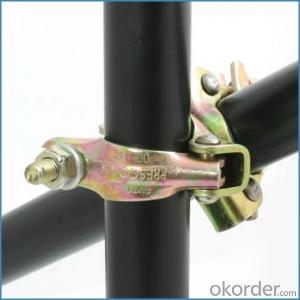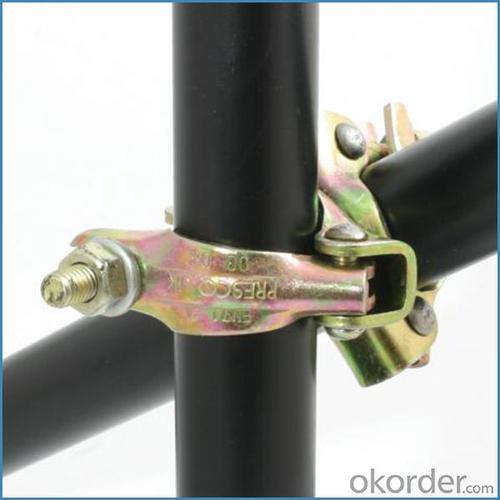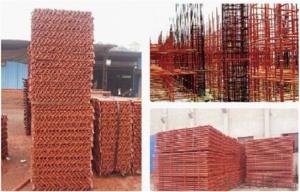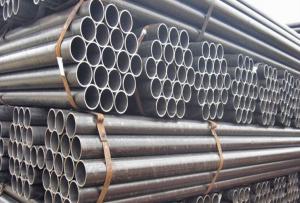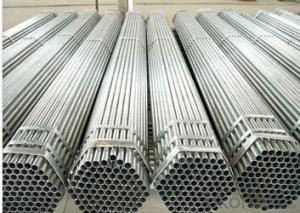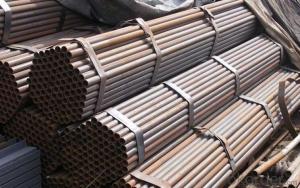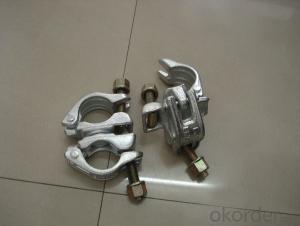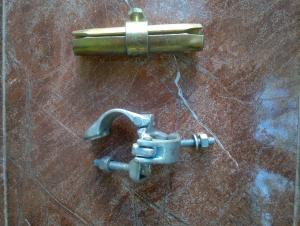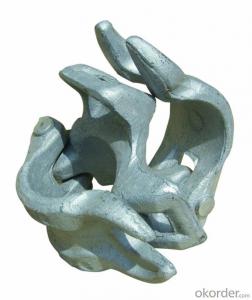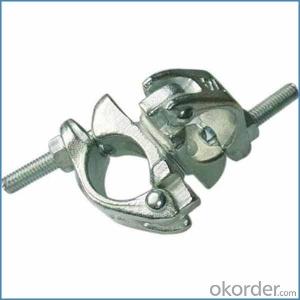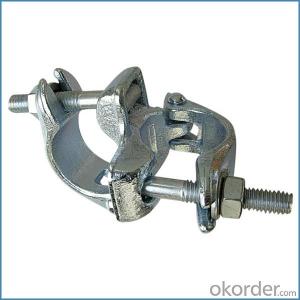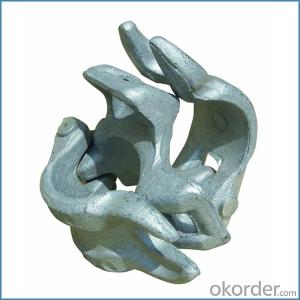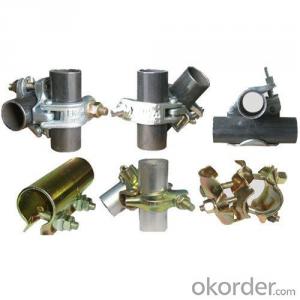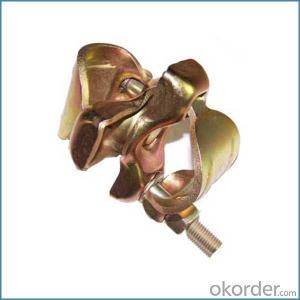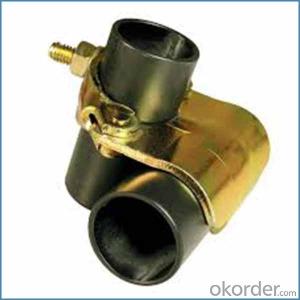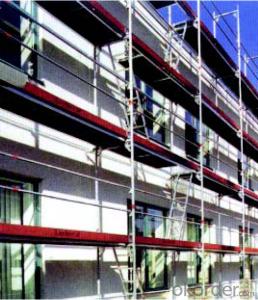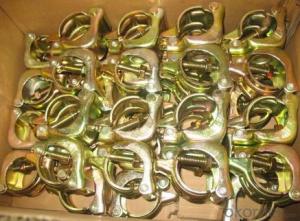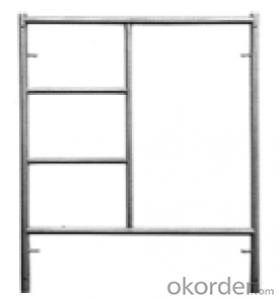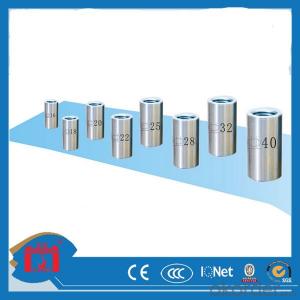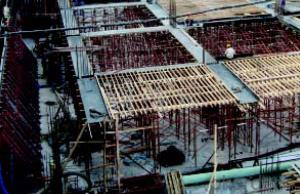Pressed Scaffold Clamp british German Forged Type
- Loading Port:
- Tianjin
- Payment Terms:
- TT OR LC
- Min Order Qty:
- 1000 kg
- Supply Capability:
- 100000 kg/month
OKorder Service Pledge
OKorder Financial Service
You Might Also Like
Pressed Scaffold Clamp british German Forged Type
Description
1.The scaffolding coupler is always used to connect the steel pipe as scaffolding system.
2.The often used coupler is swivel coupler and righ angle coupler .
3.We can provide types of scaffolding coupler according to your requirement.
4.Couoler can fix the 48.3mm scaffolding steel pipe tightly and make the whole scaffolding system more steadily.
Feature
(1)Excellent Anti-Breaking—Cold Pressed Steel
(2)Outstanding Resistance Deformation
(3)Strong Anti-Dropping Ability
Photo

Parameter
| Material | Q235,345steel |
| Size | 48.3mm*48.3mm |
| Surface finish | Galvanized |
| Weight | 1.1kg around |
| Standard | BS1139,EN74 |
| Package | 25pcs/bag,steel pallet |
| Manufacture | As per customer requirement |
| Market | Africa, South America, the Middle East and Asia |
FAQ
Q: Are you a factory or trading company?
We are a state-owned corporation in China,dealing with various kinds of building materials.We have our holding subsidiaries.
Q: Where is your factory located? How can I visit there?
Our factory is located all around China.
Q: Can I get some samples?
Sample is free, customer only pay freight for the first time.
Q: Delivery?
10-30days. (5-15 containers)
Any question,feel free to contact us.
- Q: What safety standards do steel tube couplers need to meet?
- Steel tube couplers need to meet safety standards such as load capacity, torque resistance, and corrosion resistance. They should be manufactured according to industry regulations and tested for durability and performance to ensure the safety of structures where they are used.
- Q: What is the cost of steel tube couplers compared to other scaffolding connectors?
- The price of steel tube couplers may differ based on various factors like the brand, size, and quality. Generally, steel tube couplers are known to be economical and reasonably priced when compared to other types of scaffolding connectors. One primary reason for this is the widespread availability and long-standing use of steel tube couplers in the construction industry. Due to their popularity and demand, numerous manufacturers and suppliers offer a wide selection of steel tube couplers, resulting in competitive pricing. Another contributing factor to the cost-effectiveness of steel tube couplers is their durability and strength. Steel is renowned for its sturdiness and ability to bear heavy loads, making it a reliable choice for scaffolding connectors. This durability ensures that steel tube couplers have a longer lifespan, minimizing the need for frequent replacements and maintenance costs. Moreover, steel tube couplers are versatile and can be utilized in various scaffolding applications, including connecting tubes at different angles or constructing intricate structures. This versatility eliminates the necessity of purchasing different types of connectors for specific tasks, further reducing overall expenses. However, it is essential to note that the cost of steel tube couplers may still vary depending on the project requirements and supplier. It is advisable to compare prices from different sources and consider factors like quality, certifications, and customer feedback to strike a balance between cost and reliability.
- Q: Are steel tube couplers adjustable for different angles and positions?
- The adjustability of steel tube couplers for different angles and positions is nonexistent. Their purpose lies in establishing a strong connection between two steel tubes, thereby guaranteeing structural stability and integrity. These couplers find extensive application in construction and engineering sectors, where precision and strength play a vital role. Nevertheless, if the project demands adjustable angles and positions, it is advisable to explore alternatives like swivel couplers or adjustable fittings. These options provide flexibility and enable adjustments in multiple angles and positions, thereby offering enhanced versatility in construction projects.
- Q: Are steel tube couplers resistant to extreme temperatures?
- Yes, steel tube couplers are generally resistant to extreme temperatures due to the high melting point of steel.
- Q: What are the common industry standards or certifications for steel tube couplers?
- The common industry standards or certifications for steel tube couplers vary depending on the region and specific applications. However, some widely recognized standards and certifications for steel tube couplers include: 1. British Standards (BS): The British Standards Institution (BSI) offers various standards for steel tube couplers, including BS EN 74-1:2005, which specifies requirements for steel couplers used in scaffolding applications. 2. European Norms (EN): European Norms provide a harmonized set of standards across European countries. EN 74-1:2005 is the European equivalent of the British standard mentioned above. 3. American National Standards Institute (ANSI): ANSI offers standards for steel tube couplers used in construction and industrial applications. ANSI/ASSE A10.9-2013 is one such standard that provides requirements for couplers used in scaffolding. 4. ISO Certifications: The International Organization for Standardization (ISO) offers various certifications for steel tube couplers, such as ISO 9001:2015, which ensures compliance with quality management systems. 5. Occupational Safety and Health Administration (OSHA): OSHA provides regulations and guidelines to ensure workplace safety. Although not a specific certification for steel tube couplers, OSHA regulations often require compliance with certain standards, such as ANSI/ASSE A10.9-2013, for scaffolding couplers. It is important to note that different regions or countries may have their own specific standards or certifications for steel tube couplers. Therefore, it is recommended to consult local regulations and industry associations to determine the specific standards and certifications applicable to your location and intended use.
- Q: Are steel tube couplers suitable for scaffolding projects requiring frequent movement or relocation?
- Yes, steel tube couplers are suitable for scaffolding projects requiring frequent movement or relocation. Steel tube couplers are known for their durability, strength, and versatility, making them ideal for scaffolding projects that require frequent assembly and disassembly. They provide a secure and stable connection between scaffolding tubes, ensuring the safety and stability of the structure while allowing for easy dismantling and relocation.
- Q: What are the common sizes of steel tube couplers available in the market?
- The market offers a range of steel tube coupler sizes that vary depending on the specific application and industry requirements. Some commonly utilized sizes include 1/2 inch, 3/4 inch, 1 inch, 1 1/4 inch, 1 1/2 inch, 2 inch, and 2 1/2 inch. These sizes are typically available in both standard and metric measurements, catering to diverse global markets and regions. Furthermore, specialized applications or specific industries may have access to larger or smaller sizes. To ensure compatibility with your project or needs, it is crucial to consult with manufacturers or suppliers to ascertain the exact size range they offer.
- Q: How do steel tube couplers ensure a secure connection without damaging the tubes?
- The secure connection between tubes is guaranteed by steel tube couplers, which combine design features and material properties to prevent any damage. To begin, steel tube couplers are meticulously engineered to fit the tubes perfectly, ensuring a tight and secure fit. This precise design eliminates any play or movement when the tubes are inserted into the couplers. Consequently, the risk of slippage or misalignment is minimized, resulting in a secure connection. Furthermore, steel tube couplers often incorporate internal gripping mechanisms or teeth that enhance the connection's strength and stability. These features create an interlocking effect between the coupler and the tube, evenly distributing the load across the tube surface. By doing so, any localized stress concentration that could potentially damage the tubes is minimized. In addition, steel possesses exceptional strength and durability properties, making it an ideal material for tube couplers. Its high tensile strength and resistance to deformation allow the couplers to withstand significant loads without yielding or deforming. As a result, the tubes are securely held in place without suffering any damage, even under extreme conditions or heavy loads. Moreover, steel tube couplers often incorporate protective measures, such as coatings or galvanization, to prevent corrosion. These protective layers safeguard the coupler from rust and corrosion, which could weaken the connection and potentially damage the tubes over time. By preserving the integrity of the couplers, the risk of tube damage is significantly reduced. In conclusion, the combination of precise design, internal gripping features, the strength of steel, and protective coatings ensures a secure connection between tubes without causing any damage. This comprehensive approach creates a dependable and robust connection that can withstand loads and forces without compromising the tubes' integrity.
- Q: Can steel tube couplers be used for temporary and permanent scaffolding structures?
- Yes, steel tube couplers can be used for both temporary and permanent scaffolding structures. Steel tube couplers are designed to securely connect and join steel tubes together, providing stability and strength to the scaffolding structure. They are commonly used in construction projects for both temporary scaffolding during construction and permanent scaffolding for long-term use.
- Q: What is the cost range of steel tube couplers for scaffolding?
- The cost range of steel tube couplers for scaffolding can vary depending on various factors such as the size, quality, and brand. However, in general, the cost range can be anywhere from $1 to $20 per coupler.
Send your message to us
Pressed Scaffold Clamp british German Forged Type
- Loading Port:
- Tianjin
- Payment Terms:
- TT OR LC
- Min Order Qty:
- 1000 kg
- Supply Capability:
- 100000 kg/month
OKorder Service Pledge
OKorder Financial Service
Similar products
Hot products
Hot Searches
Related keywords
